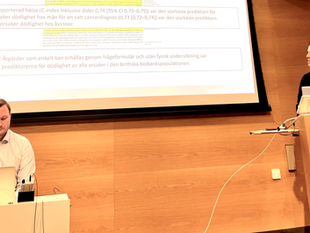
Leif Eriksson: We will be able to cure glioblastoma

Leif Eriksson and his research team have developed a molecule that even seems to work against the most aggressive cancer forms. But for the discovery to be tested in real-world situations, more funding is needed.
"For the patients, it really is a race against time," says Leif Eriksson.
Developing new medications normally takes many years – but with the breakthrough in artificial intelligence, opportunities are now opening up that researchers previously couldn’t even dream of.
And in a critical area, progress has already been made. After several years of patient research, a Swedish research team may have found a cure for the aggressive brain tumor glioblastoma, which has been recognized in both Swedish and international media.
"We will, in the future, be able to cure patients from glioblastoma," says Leif Eriksson.
"We will, in the future, be able to cure patients from glioblastoma."
Leif Eriksson is a professor of physical chemistry at the University of Gothenburg. He is leading the Swedish research team that collaborates with colleagues in France.
University of Gothenburg: Major progress in curing brain tumors

Current treatment does not cure.
The outlook for those diagnosed with this type of cancer is grim. The average patient only lives for about 15 months after diagnosis, and only 1 percent survive for ten years.
A contributing factor to the deadly nature of glioblastoma is that the cancer type grows rapidly and often remains undetected for a long time before being discovered by doctors.
The standard treatment for glioblastoma consists of surgery, radiation, and chemotherapy. The patient may also receive electrotherapy. These treatments have proven effective, but they are far from being as effective as they need to be to help patients in the long term. There is still no cure.
"Being able to use our knowledge and research tools to concretely find a cure for one of the most aggressive forms of cancer and give hope to thousands of patients provides enormous motivation in our daily work," explains Leif Eriksson.
A giant leap with a supercomputer
It was seven years ago that Leif Eriksson's team at the University of Gothenburg teamed up with colleagues at the French research institute Inserm in Rennes. The idea was to use a supercomputer to develop a molecule specifically designed to target the particular protein that glioblastoma cells depend on.

There is an almost countless number of molecules to choose from, and because the researchers wanted to find the most suitable one, it would take several years to reach a result. However, with the help of supercomputers, they were able to examine millions of molecules to find a substance that not only binds strongly and blocks the protein in question, but can also cross into the brain and is not toxic to healthy cells.
Healthy without side effects
In the midst of the pandemic, the breakthrough was achieved. Studies on French mice showed that the molecule developed, called Z4P, not only inhibited the growth of cancer cells, but was also so potent that, when combined with chemotherapy, it killed the harmful cells.
"The cancer cells' stress management system is disabled. Then the cancer cells become overloaded and die," explains Leif Eriksson.
In the mice treated with Z4P, the tumor completely disappeared, and the mice remained healthy for the rest of their lives. Furthermore, the research team noted that the mice did not experience any side effects.

Can save many lives
The result was presented in 2023 in the scientific journal *iScience*. Since the discovery, the research teams have been working on the next step: further improving the properties of the molecule and then determining the optimized dosage and treatment duration, before moving on to larger animals than mice and eventually to human patients.

Every year, around 250,000 people are diagnosed with glioblastoma worldwide. A proven treatment could completely revolutionize these individuals' chances of survival.
Funding is required for the next step
However, more funding is needed for the project. According to Leif Eriksson's estimates, reaching the stage for clinical trials requires an additional 4-5 million euros — money that has not yet been secured.
In light of the results the team has achieved so far, however, he is hopeful that investors, foundations, and EU funds will prioritize the project and see the same potential that he does.
"We are well on our way to finding a cure for a very deadly tumor. Therefore, I believe that once we reach clinical trials, everything will accelerate. There is an urgent need for better treatment for aggressive cancer," says Leif Eriksson.
"There is an urgent need for better treatment for aggressive cancer."
It could work on more types of cancer
He is often contacted by glioblastoma patients and their families. The only thing they can do at this point is to undergo existing treatments and live on hope. But not for much longer.
"It’s a race against time. The faster we start with the clinical work, the more lives we can save and impact," says Leif Eriksson.
He also has high hopes that the research will lead to a cure for other aggressive cancers, such as pancreatic cancer, triple-negative breast cancer, and certain liver cancers.
_PNG.png)





